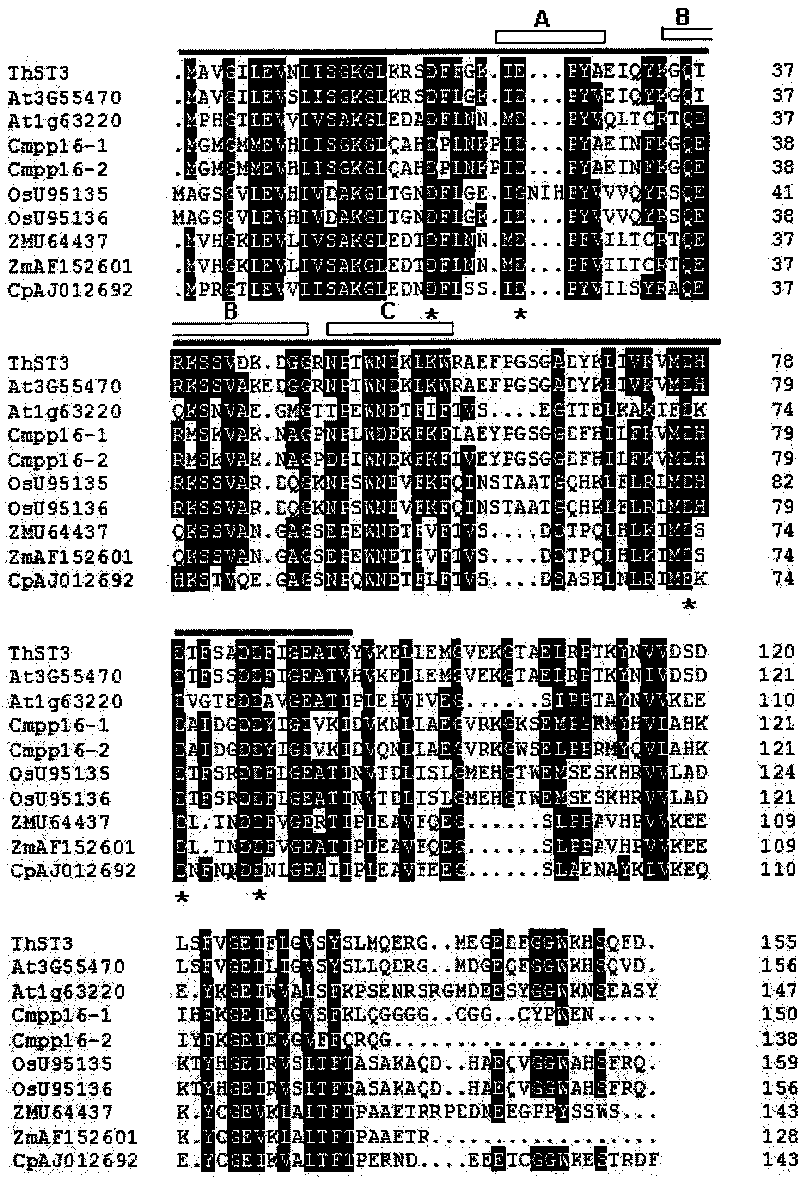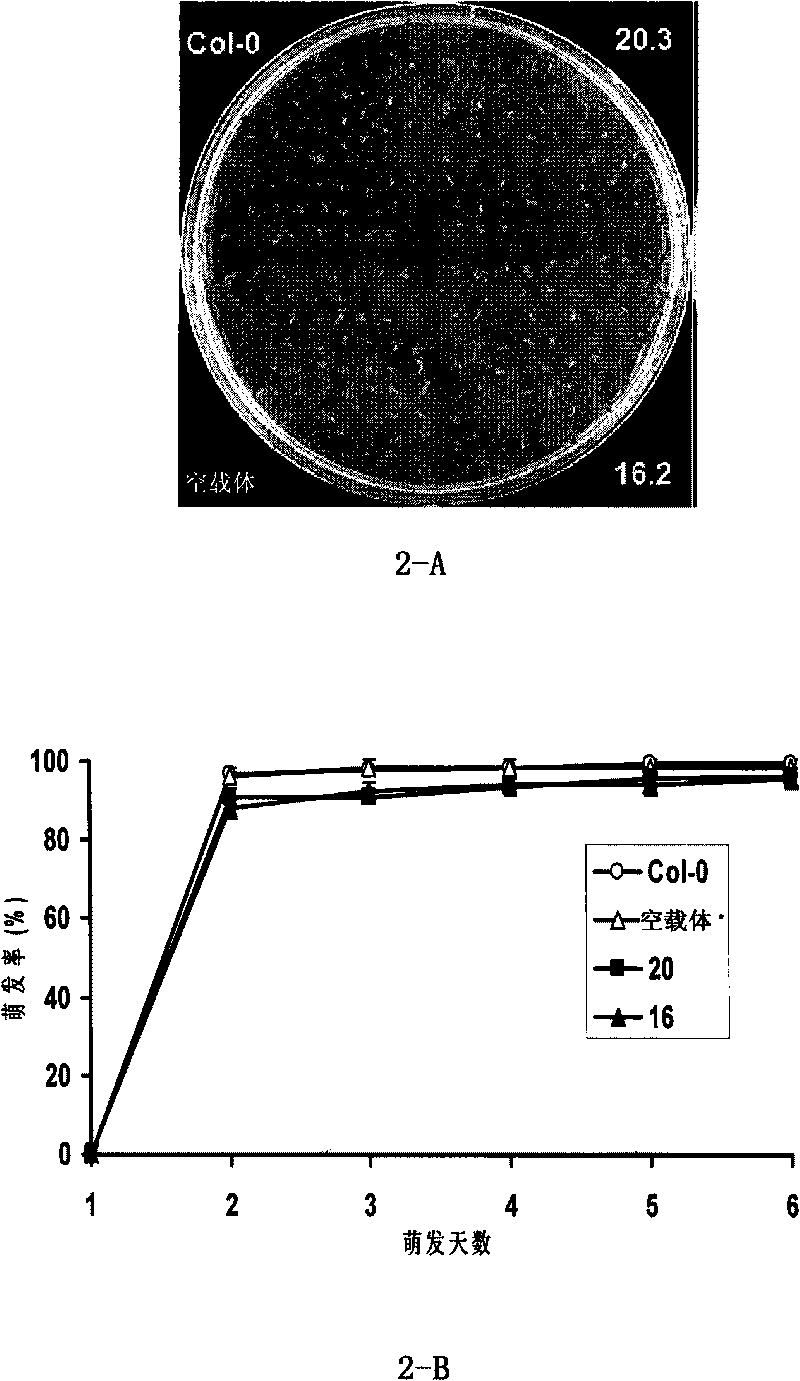Protein related to salt tolerance, coding gene thereof and application thereof
A technology that encodes genes and proteins, applied in applications, genetic engineering, plant genetic improvement, etc., can solve problems such as slow growth, shedding, death, etc., and achieve the effect of improving salt tolerance and increasing yield
- Summary
- Abstract
- Description
- Claims
- Application Information
AI Technical Summary
Problems solved by technology
Method used
Image
Examples
Embodiment 1
[0044] Example 1. Screening of the salt-tolerance-related protein gene ThST3 and its cDNA cloning
[0045] 1. Screening of ThST3
[0046] The seedlings of Thellugiella halophila were treated with 200mM NaCl, the mRNA of the treated Thellugiella halophila was extracted and reverse-transcribed into cDNA, the cDNA library of Thellugiella halophila was constructed on the binary vector pGreen-SA, and the recombinant vector was used to transform Pseudomonas halophila. southern thaliana. At the same time, the Arabidopsis thaliana was transformed with the empty vector pGreen-GFP, and the obtained Arabidopsis was used as a control. The transgenic Arabidopsis was treated with 200mM NaCl, and the salt-tolerant strain was screened. It was found that strain No.0003 was more salt-tolerant than the control, and it was named ThST3 (Salt tolerant 3).
[0047] Genomic DNA of ThST3 strain Arabidopsis thaliana was extracted, the primers on the vector pGreen were used to amplify the insert fragm...
Embodiment 2
[0053] Embodiment 2, the acquisition of transgenic ThST3 gene plant and identification of stress tolerance
[0054] 1. Obtaining of ThST3 gene transgenic plants
[0055] The pTE-ThST3 vector was digested with XbaI and SacI, and the digested product was connected to the back of the 35S promoter of the binary vector pCAMBIA1300-221 (CAMBIA, Canberra, Australia) after the same digestion, and then the gene encoding the GFP fluorescent protein The recombinant plasmid was introduced to construct the sense expression vector pCAMBIA1300-221-35S-ThST3.
[0056] The sense expression vector was transformed into wild-type Arabidopsis (Col-0) by Agrobacterium-mediated vacuum infiltration. Screening was performed on an MS plate with a kanamycin concentration of 50 μg / ml, and 17 positive strains were obtained. The DNA of transgenic plants was extracted for PCR identification, and the results showed that all 17 transgenic lines were overexpressed lines of ThST3 gene. T 0 Transgenic Arabid...
Embodiment 3
[0082] Example 3, Long-distance transport activity of ThST3 protein and its application in cultivating salt-tolerant plants
[0083] 1. Long-distance transport activity of ThST3 protein
[0084] To identify whether ThST3 can carry out long-distance transport, Arabidopsis grafting experiment was carried out. Specific steps are as follows:
[0085] Get the Col-0 that grows 7d on the medium and the T from embodiment 2 3 For transgenic plants of generation 2.20, the seedlings were quickly cut horizontally from the middle of the cotyledon hypocotyl with a sharp blade, and then the breakpoints of the rootstock and the scion were quickly aligned, so that the cut surfaces of the scion and the rootstock matched as much as possible, and then melted low-melting point agar was dripped on it. After the agarose is cooled and solidified, place the plate vertically and continue to cultivate under the light. The entire operation process was carried out under a microscope and under sterile c...
PUM
 Login to View More
Login to View More Abstract
Description
Claims
Application Information
 Login to View More
Login to View More - R&D
- Intellectual Property
- Life Sciences
- Materials
- Tech Scout
- Unparalleled Data Quality
- Higher Quality Content
- 60% Fewer Hallucinations
Browse by: Latest US Patents, China's latest patents, Technical Efficacy Thesaurus, Application Domain, Technology Topic, Popular Technical Reports.
© 2025 PatSnap. All rights reserved.Legal|Privacy policy|Modern Slavery Act Transparency Statement|Sitemap|About US| Contact US: help@patsnap.com



